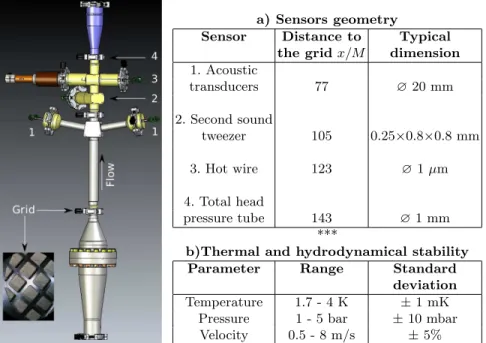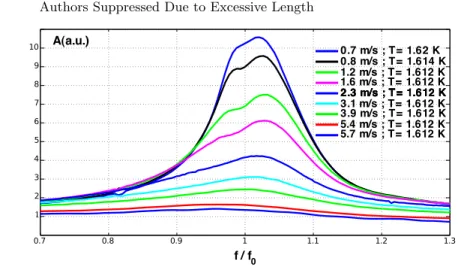HAL Id: hal-00430197
https://hal.archives-ouvertes.fr/hal-00430197
Submitted on 9 Aug 2010
HAL is a multi-disciplinary open access
archive for the deposit and dissemination of
sci-entific research documents, whether they are
pub-lished or not. The documents may come from
teaching and research institutions in France or
abroad, or from public or private research centers.
L’archive ouverte pluridisciplinaire HAL, est
destinée au dépôt et à la diffusion de documents
scientifiques de niveau recherche, publiés ou non,
émanant des établissements d’enseignement et de
recherche français ou étrangers, des laboratoires
publics ou privés.
TSF Experiment for comparision of high Reynold’s
number turbulence in He I and He II : first results
Pantxo Diribarne, Julien Salort, Christophe Baudet, Benoit Belier, Bernard
Castaing, Laurent Chevillard, François Daviaud, Sylvain David, Bérengère
Dubrulle, Yves Gagne, et al.
To cite this version:
Pantxo Diribarne, Julien Salort, Christophe Baudet, Benoit Belier, Bernard Castaing, et al.. TSF
Experiment for comparision of high Reynold’s number turbulence in He I and He II : first results.
12th EUROMECH European Turbulence Conference, Sep 2009, Marburg, Germany. pp.701-704,
�10.1007/978-3-642-03085-7_169�. �hal-00430197�
Reynold’s number turbulence in He I and
He II : first results.
P. Diribarne1,6, J. Salort2 , C. Baudet5,6, B. Belier8 , B. Castaing3 , L. Chevillard3 , F. Daviaud4 , S. David8 , B. Dubrulle4 , Y. Gagne5,6, A. Girard1 , B. Rousset1 , P. Tabeling7 ,P. Thibault1 , H. Willaime7 and P.-E. Roche2 1Service des Basses Temp´eratures/CEA/INAC, Grenoble, France
2
Institut Neel/CNRS Grenoble, France
3
Laboratoire des ´Ecoulements G´eophysiques et Industriels/CNRS, Grenoble, France
4 ´
Ecole Normale Sup´erieure de Lyon/CNRS, Lyon, France
5
Service de Physique de l’´Etat Condens´e/DSM/CEA Saclay, CNRS, Gif-sur-Yvette, France
6
Universit´e Joseph Fourier, Grenoble, France
7
LMMN, ESPCI / CNRS, Paris, France
8
IEF, Universit´e d’Orsay / CNRS, Orsay, France pantxo.diribarne@cea.fr
Summary. Superfluid turbulence (TSF) project uses liquid helium for the funda-mental study of turbulent phenomena behind a passive grid and is able to work both in HeI and in HeII. Local and semi-local instrumentation was developed specifically for the purpose of this experiment(e.g. sub-micrometer anemometer, total head pres-sure tube and second sound tweezer). The difficulties encountered with this local and fragile instrumentation are discussed. Global characterization of the flow is presented including velocity, pressure, temperature stability and turbulence intensity. Finally, first results obtained with semi local measurements (total head pressure tube and second sound tweezer) both in the two phases of helium are presented.
1 Experimental facility and sensors
The experiment is a closed loop, containing three main sections : a pump, a heat exchanger and the experimental section. The helium flow is generated by the cryogenic pump. The temperature is controled by means of the heat exchanger immersed in a liquid Helium saturated bath. This experiment takes profit of the CEA Grenoble refrigerator (nominal capacity of 400 Watt at 1.8 K) to remove the heat due to the energy dissipated in this high Reynolds
num-2 Authors Suppressed Due to Excessive Length
ber experiment. Thermodynamical caracteristics of the flow are summarized in table b of fig.1.
The experimental section (see fig. 1) is made of a 27.2 mm inside diameter tube fitted with specifically designed sensor inserts. Much care was taken to avoid wall discontinuities due to the presence of the sensor mountings. The grid mesh size is M = 3.9 mm with 3.1mm square holes with 0.8 mm wide boundaries.
a) Sensors geometry
Sensor Distance to Typical the grid x/M dimension 1. Acoustic transducers 77 ∅20 mm 2. Second sound tweezer 105 0.25×0.8×0.8 mm 3. Hot wire 123 ∅ 1 µm 4. Total head pressure tube 143 ∅1 mm ***
b)Thermal and hydrodynamical stability Parameter Range Standard
deviation Temperature 1.7 - 4 K ±1 mK
Pressure 1 - 5 bar ±10 mbar Velocity 0.5 - 8 m/s ±5%
Fig. 1. Left : a sketch of the experimental section of TSF. Right : table a summarize position and spatial resolution of the probes, table b shows the thermodynamical parameters range and stability.
Four types of probes are available on TSF facility. There location and typ-ical spatial resolution are summarized in table b of fig. 1.
Ultrasonic vorticity probe is based on scattering of ultrasonic waves by
the flow vorticity at a chosen wave vector [3, 1]. In order to insure the non-invasiveness of the probe, it was necessary to add a thin wall between the transducers (transmiter and receiver) and the flow. Unfortunatly, in those conditions, the resulting signal could not be properly interpreted.
Second sound tweezer was used to measure the quantized vortex density
L0. It is based on the attenuation of a second standing wave between an
em-mitter (heating surface) and a very sensitive superconducting temperature probe [5].
Superconducting hot wire is designed following the principle of Cas-taing [2]. A bulk NbTi wire is used instead of a coated glass fiber in order to improve the spatial resolution and the sensitivity of the probe. The active part of the wire is obtained by locally reducing its cross section. This leads to a very fragile probe and few data could be acquired. Those measurements are not discussed in the present paper.
Total head pressure tubeis inserted at the end of the experimental section.
As in the experiment of Maurer and Tabeling [4], the pressure fluctuations at the stagnation point are assumed to be proportionnal to velocity fluctuations. This probes is thus used as an anemometer working both in He I and He II.
2 First results
10 100 1000 10000 1e-12 1e-10 1e-08 1e-06 PSD (a.u.) V=1.53 m/s, He II V=1.5 m/s, He II V=1.47 m/s, He I 10 100 f (Hz) 1e-08 1e-07 1e-06 1e-05 0,0001 PSD.f 5/3Fig. 2. Main graph : power spectral density (PSD) of the velocity compensated with f−5/3. Inset : rought PSD in arbitrary units. Above 500 Hz the signal is strongly
altered by a Helmoltz resonnance in the pressure tube
In this section we show two preliminary results obtained with the total head pressure tube and the second sound tweezer.
In fig. 2 we have plotted the Power Spectral Density of the velocity. We see
from the compensated spectrum that the PSD is compatible with a f−5/3
power law, both in He I and He II. The similarity between the upper inertial range in He I and II has already been reported by Maurer and Tabeling [4]
in von K´arm´an flow with a higher turbulence intensity. Here, computed
tur-bulence intensity is about 2%, consistent with expected values in such con-figurations, and does not depend on the helium phase. The geometry of the probe will now be improved to reach higher spatial and temporal resolution.
Preliminary results of the second sound tweezer are shown in fig. 3. We see that the amplitude of the temperature wave decreases with velocity. This is
4 Authors Suppressed Due to Excessive Length ������ ������� ������������������� 1 2 3 4 5 6 7 8 9 10 0.7 0.8 0.9 1 1.1 1.2 1.3 �������������������� �������������������� �������������������� �������������������� �������������������� �������������������� �������������������� �������������������� �������������������� ��������������������
Fig. 3. Amplitude A of the measured temperature standing wave as a function of the driving frequency normalized with the expected resonnance frequency f0. From
top to bottom the curves correspond to increasing velocities.
due to increasing vortex lines density L0 in the flow. Since L0can be viewed
as the superfluid enstrophy, it provides a direct integral information about the
smallest scales of the superfluid flow. Thus, the increase of L0versus the flow
Reynolds number reflects the increase of the depth of the superfluid cascade.
3 Conclusion
We have succeeded in stabilizing a high Reynols steady superfluid flow. First results of TSF experiment tend to confirm the present understanding of su-perfluid turbulence and particularly the similarity with classical turbulence at large scale in a grid experiment. On-going work include quantitative anal-ysis of the Reynolds number dependence of the superfluid cascade depth and velocity fluctuation measurements with improved space and time resolution.
References
1. C. Baudet, S. Ciliberto, and J. F. Pinton. Spectral analysis of the von k´arm´an flow using ultrasound scattering. Phys. Rev. Lett., 67(2):193–195, Jul 1991. 2. B. Castaing, B. Chabaud, and B. H´ebral. Hot wire anemometer operating at
cryogenic temperatures. Rev. of Sci. Inst., 63(9):4167–4173, 1992.
3. F. Lund and C. Rojas. Ultrasound as a probe of turbulence. Physica D, 37:508– 514, 1989.
4. J. Maurer and P. Tabeling. Local investigation of superfluid turbulence. Euro-phys. Lett., 43 (1):29, 1998.
5. P.-E. Roche, P. Diribarne, T. Didelot, O. Fran¸cais, L. Rousseau, and H. Willaime. Vortex density spectrum of quantum turbulence. EPL, 77:66002, 2007.


